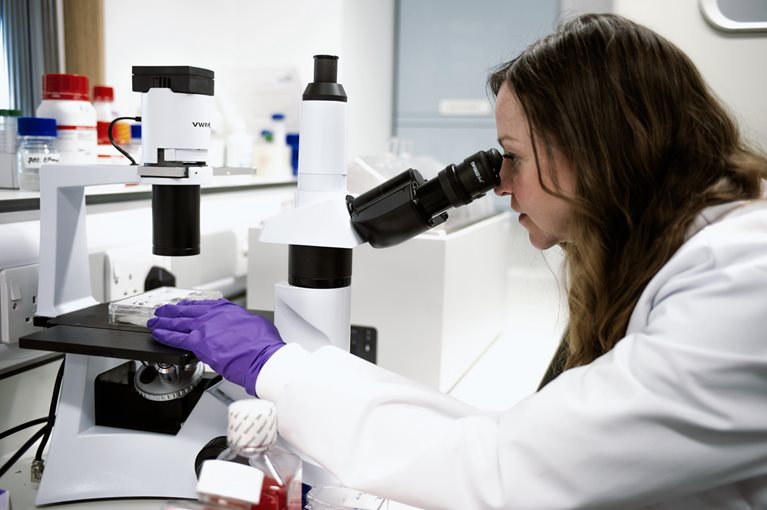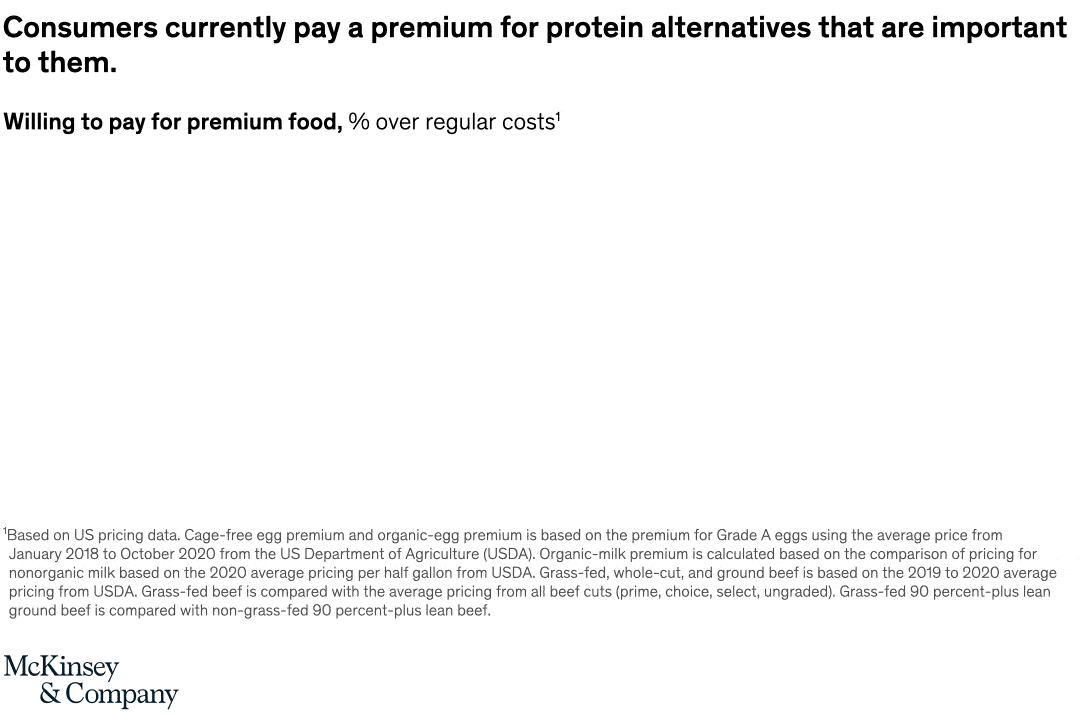Cultivated meat, a product that a handful of restaurant patrons bit into for the first time in December, could change the world’s menus in astonishing ways. It could mean that one day consumers will pay no more for Wagyu beef and bluefin tuna than for chicken nuggets and burgers. It could mean a small island could serve up beefy platters at the same cost and efficiency as a continent with wide, grassy plains. By 2030, cultivated meat could provide as much as a half of 1 percent—billions of pounds—of the world’s meat supply, with implications for multiple sectors.
What is cultivated meat?
If these sound like sci-fi fantasies, consider that just a decade ago, cultivated meat was little more than the futuristic dream of a handful of academic scientists. Instead of relying on animal husbandry to provide meat, or approximating the characteristics of meat with plants, they endeavored to create meat by taking small samples of animal cells and growing them in a controlled environment. Through manipulation of cell density and shaping techniques, the resulting product could be made to replicate the experience of eating, say, chicken breast or ground beef (Exhibit 1).

This mission seems to be becoming reality, demonstrating the speed at which advances in biological science are fueling a wave of innovation. Since developing the first prototypes, companies have been able to reduce production costs by 99 percent. In late 2020, at an upscale club in Singapore—the only country thus far to approve consumption of cultivated meat—diners feasted for the first time on crispy sesame chicken with the central ingredient grown from animal cells. Regulatory bodies in the United States have announced agreements to regulate the product, while the European Union awarded a multimillion-euro grant for research. The industry, which at present comprises fewer than 100 start-ups, attracted roughly $350 million in investments in 2020 and about $250 million thus far in 2021 from some of the largest animal-protein players, including Tyson and Nutreco, and well-known investors, including Temasek and SoftBank.
A lot has to happen for cultivated meat to become a major industry—not least that tens of billions of dollars need to be spent to scale it to even 1 percent of the global protein market. The focus of the next decade will likely be on proving commercial viability, with modest market penetration. To succeed, the industry must assuage potential concerns around a novel food while delivering deliciousness at the right price.

The future pace of adoption and market size will depend on five key factors:
- Consumer acceptance. Will diners dig into cultivated chicken nuggets and burgers and, eventually, filet mignon and salmon steaks?
- Risks. How will the industry address concerns about health and safety, jobs, and possible economic ripple effects?
- Cost position. Will cultivated meat become a bargain, relative to conventional meat, energizing demand?
- Policy response. How will countries and regions address the development of this new industry?
- Supply. Will the world make enough cultivated meat to achieve economies of scale?
What's on the horizon for this industry?
This article provides an overview of the steps required to create a global cultivated-meat industry and identifies opportunities for participation for food and pharmaceutical companies; flavor and fragrance players; engineering, procurement, and construction firms; investors; and others.
Will consumers dig into cultivated meat?
Eating meat from animals is an atavistic part of the human story, demonstrated by the enormity of the global animal-protein market (Exhibit 2).

The deep psychological and cultural ties consumers have to conventional meat are a double-edged sword. On the one hand, the opportunity to participate in the global meat market is huge. On the other, consumers know exactly how their salmon steaks and chicken tenders should taste and feel. These subtleties make replicating the meat experience tricky. Companies like Aleph Farms, Matrix Meats, and Redefine Meat are exploring a range of solutions, from extrusion to 3-D printing to microcarriers (structures that cells can attach to within bioreactors to create 3-D structures).
Consumers will also need to know how to recognize this new protein source and distinguish it from both conventional meat and plant-based alternatives. That raises the question of what this industry will be called (see sidebar, “What’s in a name?”).
What’s in a name?

Cultivated meat has the potential to not just match but surpass the taste and texture of conventional meat, as well as to introduce novel products. If consumers take to these products, the market for cultivated meat could reach $25 billion by 2030 (Exhibit 3). Currently, the world primarily eats the meat of animals that are the easiest to farm industrially, but cultivated meat won’t face those constraints. Instead, the industry could select cell lines from specific animals with the best traits, such as Wagyu beef or wild salmon, and replicate them at the same cost as, say, beef patties or tilapia.

Cultivated meat can also go one step further and select cell lines from animals that are not widely eaten because of their low meat content, long growing time, or lack of availability. For example, ostrich meat, a product that has challenged many ranchers, could be cultivated and become a trendy low-fat, red-meat alternative. There could even be room for highly creative product innovation: the industry’s imaginative take on dodo poultry could make a better nugget than chicken, or a burger made of what research chefs think mammoth might have tasted like could be a mouthwatering new concept.
While most start-ups are focusing first on more popular species and breeds, Eat Just’s GOOD Meat and the company Orbillion Bio are exploring Wagyu, and the company Vow is working to explore more exotic options, such as kangaroo and alpaca.
In the nearer term, companies may choose to focus on a single area and mix plant protein and other flavors into their products to achieve the desired taste and texture. Eat Just’s chicken product sold in Singapore, for example, is more than 70 percent cultivated cells, with a small amount of plant protein added in for structure, while Future Meat in Israel mixes cultivated fat with plant protein. It’s too early to tell if blended options are merely an interim fix or if they present a sufficiently compelling option for long-term adoption.
How will the industry handle health and economic concerns?
Consumers must not only enjoy cultivated meat but also trust it. The onus will be on producers to make consumers confident that cultivated meat is as safe—and as nutritious—as conventional meat products. While this may be a hurdle in the near term, health and nutrition may prove an advantage in the longer term if cultivated-meat producers can demonstrate a track record of safety (for example, by minimizing foodborne-illness risk) or release tailored (for example, “extra lean”) products with superior nutrition profiles.
Potential health risks could affect the reputation of cultivated meat, such as the fact that novel processes may introduce ingredients for which the health effects are unknown and require further study. Furthermore, nutritional content may vary, and consumer education may be required to ensure that consumers properly supplement their diets, if necessary.
Cultivated meat also gives rise to several economic and social issues that could raise concerns. The first involves cost: cultivated meats will initially bear a premium price tag, which may put it out of reach for some consumers, though prices will likely fall as the industry scales.
More complex issues include the possibility that the cultivated-meat industry could eventually disrupt animal-protein prices, perhaps within ten years or so of continued growth. For example, if certain cuts of meat (such as filet mignon) are replaced by cultivated options, cheaper cuts of conventional meat may cost more to account for lost sales of pricier cuts. Furthermore, the growth of cultivated meat could reduce farm sizes, impacting economies of scale and causing price increases for consumers of conventional meat.
If cultivated meat gains traction, in the long term it may also have an impact on jobs. Cultivated-meat production requires a similar number of workers as the conventional system, but the jobs require very different skills.
Finally, because cultivated-meat production doesn't require any particular climate or topography, there could be regional effects, such as a meat producer losing at least some of its competitive advantage to producers in other parts of the country—or world.

What will it take to compete on price?
In less than a decade, companies have been able to reduce the production costs of cultivated meat by 99 percent. If costs follow the same trajectory as that of human genome sequencing (for which costs, on average, dropped by 45 percent annually between 2001 and 2021), cultivated meat can achieve cost parity with conventional meat by 2030 (Exhibit 4).

It won’t be easy. Production costs for cultivated meat today remain well above those of conventional animal protein. The high cost is a result of lab-scale and pilot-scale production and remaining technical challenges. Based on a McKinsey analysis, about 75 percent of costs can be eliminated through increased scale and best-in-class manufacturing processes, while roughly 25 percent of additional costs can be eliminated by fine-tuning R&D, bringing the total cost down 99.5 percent, from the low thousands of dollars to under $5 per pound. Further cost reduction can be achieved by blending cultivated meats with plant protein.
It could take about a decade for consumers to start paying less for cultivated meat than its conventional counterpart. However, there is evidence in today’s marketplace that consumers are willing to pay extra for products they believe to be healthier or more sustainable (Exhibit 5).

In moving from pilot scale to manufacturing scale, cost reductions will come from bulk purchasing of key inputs, such as glucose and media ingredients, increased batch quantity and size, and using fit-for-purpose bioreactors (for example, food grade versus pharma grade). As plants improve in design and grow in scale, the utilities required per unit of output will likely also come down.
Would you like to learn more about our Agriculture Practice?
R&D improvements are also necessary to compete on price and quality with conventional meat. First and foremost, the cost of media (the broth in which cells grow) will need to come down. Ways to lower media costs include minimizing use of growth factors, optimizing filtration processes, and maximally recycling media. Improving cell productivity is another way to increase output per batch. This is achieved by increasing cell density in media through cell-line optimization and improving cell-culture feeding processes to maximize density and minimize media consumption and batch time.
How will policy makers respond?
The development of the cultivated-meat industry could have social and economic consequences that attract attention from policy makers and regulators. How they address these issues will in turn have implications for companies operating in this new market. Here we offer a look at several matters that could affect the industry’s standing with governments
For every 500,000 metric tons of cultivated protein (roughly 0.1 percent of the 2030 global protein market), 5,000 to 5,500 factory jobs are likely needed, which is about the same number of production jobs needed to produce protein through conventional methods.1 The majority of jobs are expected to be those of frontline staff (such as plant operators and supervisors), while 10 to 20 percent of the profiles are expected to be for bio-processing engineers. Beyond direct production, jobs will also be needed to support development of key inputs (such as media, cell lines), equipment (such as bioreactors), non-plant tasks (such as marketing, finance), and R&D.
The very different skills required by cultivated meat raises the question of how labor will be reskilled and redeployed. Because cultivated-meat production is untethered from climate considerations, these jobs could be located far from where conventional-meat jobs are located today. States or countries that have historically accounted for an outsize share of production could see a shift to new geographies that may be closer to urban centers, have specialized labor, or other advantages, such as cheaper utility prices. Job losses relative to the conventional system are also possible if the jobs created for input production for cultivated meat do not surpass those that could be lost from animal ranchers.
The industry could prove attractive to some jurisdictions because of its potential to be more sustainable. A recent Life Cycle Assessment by CE Delft found that cultivated meat is significantly (over 75 percent) more sustainable by measures such as CO2 production and land and water usage than beef and has a sustainability profile similar to that of poultry and pork.2 Cultivated meat’s sustainability profile can be better than that of chicken or pork if sustainable energy is used or if process improvements are implemented, such as if cooling is not needed for the bioreactors.3

How can cultivated meat scale up to a global industry?
What kinds of companies can be part of this industry?
Reaching a $25 billion cultivated-meat market by 2030 will require the annual production of 1.5 million tonnes of cultivated meat. At current levels of cell-culture productivity, the industry would need anywhere from 220 million to 440 million liters of fermentation capacity, enough to fill 88 to 176 Olympic-size swimming pools. Considering that the pharma industry’s current cell-culture capacity is estimated to be between 10 million and 20 million liters4 (less than ten swimming pools), it will take a massive capital build-out just to reach 1 percent of the protein market.
Getting this capital build-out right from the start will be critical to the affordability of cultivated meat. We see three challenges for companies to address in close collaboration with advanced-industry equipment manufacturers and engineering and construction (E&C) firms.
1. Figure out the raw-materials supply chain
Considering only the consumables and raw materials needed for cultivated meat, scaling the industry will require, at minimum, access to large and consistent supplies of sugar, basic media components, and more complex media components such as growth factors. Of these, sugar is the most straightforward in that the needs of cultivated meat are similar to other fermentation processes: cells need energy in the form of sugars to grow.
Basic media components, ranging from necessary minerals to amino acids, are generally easy to scale from existing sources. Affordable scaling—optimizing for the right product grade and leveraging economies of scale—is essential.
Scaling the more complex media additives, however, might require the formation of an industry of its own. These more complex ingredients, which vary by cell line, include growth promoters and signaling compounds like insulin and micronutrients.
2. Develop a streamlined manufacturing process
Cultivated-meat players should set up processes to produce the first pounds of cultivated meat with the endgame in mind, configuring manufacturing operations to allow rapid expansion. Consistent with virtually any scaling of an industrialized process, cultivated-meat production will require simplification, including limited unit operations and human intervention.
Fortunately, a number of commercial operations can serve as good models, such as the fermentation systems used for large-scale synthesis of small molecules. These processes involve scale-up steps that are common in the fermentation industry and can be emulated by cultivated-meat makers.
Understanding and controlling variability will be important to create a robust, scalable process that is efficient both in energy and raw-material inputs. Advanced analytics and machine learning, which are now gaining steam in pharma, can be used to identify sources of variability in manufacturing and to make improvements.
3. Create easy-to-build factory designs
Factories and factory components need to be highly modular so they can be located wherever there is access to affordable feedstocks (primarily energy and sugar) and receptive customers (population centers). Therefore, the ability to design “cookie-cutter” facilities that can be rapidly built at tunable capacities throughout the world will be key to supporting the industry’s expansion.
One inspiration for modular design can be found in cell culture for pharma manufacturing. As production of monoclonal antibodies (mAbs) has increased over time, a modular plant design that can accommodate multiple mAb products has taken hold. This “six-pack” design, a grouping of six large-scale bioreactors with associated scale-up and purification equipment, allows manufacturers to take the same design elements and configure them to achieve the required footprint and expected output of any given plant.
What are the steps for cultivating a future?
Studying cultivated-meat start-ups—their approach to R&D, to production, to the market—is a fundamental first step to understanding the future of cultivated meat. To play a role in that future, companies must grasp the big picture and determine which of their capabilities fit with which piece of the puzzle (Exhibit 6).

Some established companies are well positioned to reconfigure their existing functions for this opportunity. Fermentation companies, for example, can develop tailored growth media; the industrial-enzymes industry can make signaling compounds (such as insulin and growth factors) at scale and at food grade, not pharma grade; and farmers with animal breeding lines that have superior taste characteristics could provide cell lines for replication.
Cultivated-meat players that can identify the right plant design and construction partners from the start will be best positioned for scaling. E&C majors, for their part, should recognize the opportunity this industry presents, and also consider the diverse needs of start-ups, which for the most part haven’t manufactured at scale. Companies with AI and machine-learning capabilities can partner with manufacturers to solve variability issues.
Agricultural and food companies will want to examine this developing market and seek opportunities for both collaboration and differentiation from their conventional-meat products. Some companies may contemplate joint ventures that enable them to play an integral role in the cultivated-meat industry, while others will focus on providing inputs or machinery to the industry or buying outputs from the industry.
Cultivated meat has garnered significant attention as a protein source that can meet consumer needs with a reduced impact on the planet. That potential is real. Further investment, ingenuity, and commitment are likely needed to move this concept from a novel small-batch product to one of the tempting protein options on millions, if not billions, of people’s plates.


